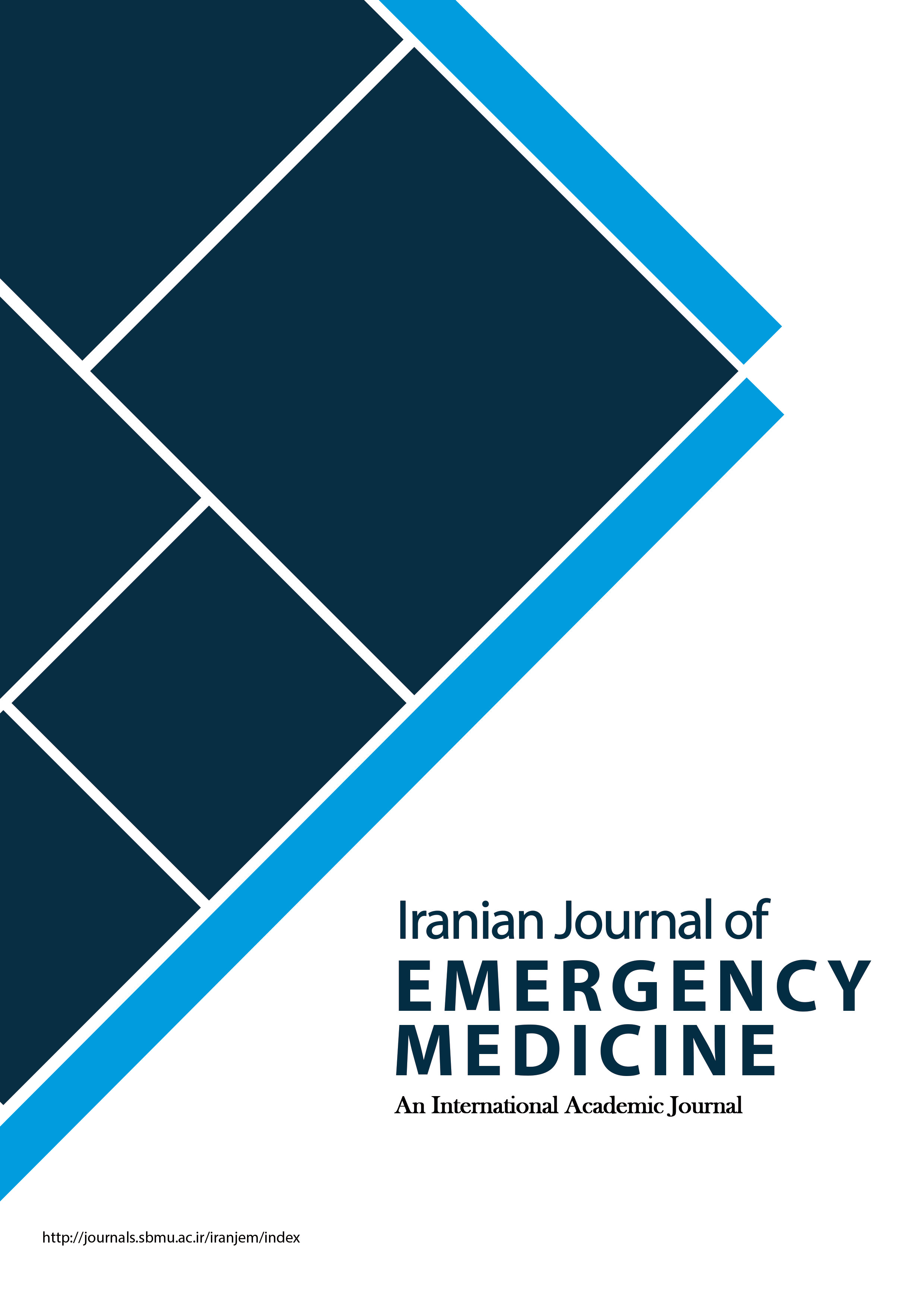Evaluation of the Troponin Measurements Results in Patients with Acute Coronary Syndrome; a Brief Report
Iranian Journal of Emergency Medicine,
Vol. 4 No. 1 (2017),
21 December 2016
,
Page 39-35
https://doi.org/10.22037/ijem.v4i1.14429
Abstract
Introduction: The present study aimed to evaluate the rate of positive cases in measurement of serum troponin level in patients presenting to emergency department (ED) with complaint of chest pain who were dispositioned to coronary care unit (CCU) due to probable acute coronary syndrome. Methods: This cross-sectional study was carried out between September 2014 and September 2015 in ED and CCU of Shahid Modarres Hospital, Tehran, Iran. Using the archives, profiles of patients dispositioned from ED to CCU with diagnosis of acute coronary syndrome were evaluated. No age or sex limitation was imposed in this study. Data were extracted from the profiles and were recorded using a checklist consisting of points considered in history taking and results of troponin tests. Troponin tests were taken on admission, and 3, 6, 12, 18, 24, 36, 48, and 72 hours after that. A serum troponin level higher than 0.6µg/dL was considered positive. Results: 384 patients with the mean age of 62.34 ± 12.00 years (range: 30 -93) were included in the study (66.7% male). 230 (59.9%) patients with diagnosis of myocardial infarction, 149 (38.8%) with unstable angina, and 5 (1.3%) with other diagnoses were hospitalized. 252 (65.6%) of the patients had complained of typical chest pain. The most common accompanying symptom was shortness of breath present in 107 (27.9%) patients. Hypertension, hyperlipidemia, and diabetes were the most common accompanying diseases with 49, 35.2, and 30.5%, prevalence respectively. In total, 275 (71.6%) of troponin tests were reported to be positive. In the end, 362 (94.3%) patients were discharged from CCU with good general health and 22 (5.7%) died. Conclusion: Based on the findings of the present study, in the initial 72 hours of admission, troponin test result was positive in 70% of patients who were dispositioned to CCU with probability of cardiac chest pain, in 50% of which the test result was positive on admission.- درد قفسه سینه؛ تروپونین؛ سندرم کرونری حاد؛ بیومارکرها
How to Cite
References
Dolatabadi AA, Kashani P, Hatamabadi H, Kariman H, Baratloo A. Using risk factors to help in the diagnosis of acute myocardial infarction in patients with non-diagnostic electrocardiogram changes in emergency department. Journal of Emergency Practice and Trauma. 2015;1(1):3-6.
Farkouh ME, Douglas PS. The Management of Acute Chest Pain: What Lies Beyond the Emergency Department Doors? Journal of the American College of Cardiology. 2016;67(1):27-8.
Brieger D, Eagle KA, Goodman SG, Steg PG, Budaj A, White K, et al. Acute coronary syndromes without chest pain, an underdiagnosed and undertreated high-risk group: insights from the Global Registry of Acute Coronary Events. Chest Journal. 2004;126(2):461-9.
Apple FS, Pearce LA, Chung A, Ler R, Murakami MM. Multiple Biomarker Use for Detection of Adverse Events in Patients
Presenting with Symptoms Suggestive of Acute Coronary Syndrome. Clinical Chemistry. 2007;53(5):874-81.
Fanaroff AC, Rymer JA, Goldstein SA, Simel DL, Newby LK. Does this patient with chest pain have acute coronary syndrome?: the rational clinical examination systematic review. JAMA. 2015;314(18):1955-65.
Keller T, Zeller T, Peetz D, Tzikas S, Roth A, Czyz E, et al. Sensitive Troponin I Assay in Early Diagnosis of Acute Myocardial Infarction. New England Journal of Medicine. 2009;361(9):868-77.
Miller WL, Garratt KN, Burritt MF, Lennon RJ, Reeder GS, Jaffe AS. Baseline troponin level: key to understanding the importance of post-PCI troponin elevations. European heart journal. 2006;27(9):1061-9.
Thygesen K, Mair J, Katus H, Plebani M, Venge P, Collinson P, et al. Recommendations for the use of cardiac troponin measurement in acute cardiac care. European heart journal. 2010;31(18):2197-204.
Hochman JS, Tamis JE, Thompson TD, Weaver WD, White HD, Van de Werf F, et al. Sex, clinical presentation, and outcome in patients with acute coronary syndromes. New England Journal of Medicine. 1999;341(4):226-32.
Pervaiz S, Waskiewicz D, Anderson FP, Lawson CJ, Lohmann TP, Feng YJ, et al. Comparative analysis of cardiac troponin I and creatine kinase‐MB as markers of acute myocardial infarction. Clinical cardiology. 1997;20(3):269-71.
Wu AH, Jaffe AS. The clinical need for high-sensitivity cardiac troponin assays for acute coronary syndromes and the role for serial testing. American heart journal. 2008;155(2):208-14.
Antman E, Bassand J-P, Klein W, Ohman M, Sendon JLL, Rydén L, et al. Myocardial infarction redefined—a consensus document of the Joint European Society of Cardiology/American College of Cardiology committee for the redefinition of myocardial infarction: the Joint European Society of Cardiology/American College of Cardiology Committee. Journal of the American College of Cardiology. 2000;36(3):959-69.
Mahajan N, Mehta Y, Rose M, Shani J, Lichstein E. Elevated troponin level is not synonymous with myocardial infarction. International Journal of Cardiology.111(3):442-9.
- Abstract Viewed: 2306 times
- PDF (فارسی) Downloaded: 647 times
- HTML (فارسی) Downloaded: 126 times



